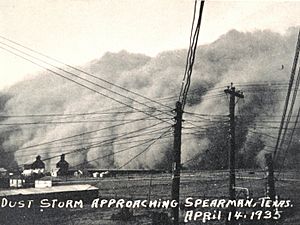Black Sunday (storm) facts for kids
Black Sunday refers to a particularly severe dust storm that occurred on April 14, 1935 as part of the Dust Bowl in the United States. It was one of the worst dust storms in American history and it caused immense economic and agricultural damage. It is estimated to have displaced 300 thousand tons of topsoil from the prairie area.
On the afternoon of April 14, residents of several plains states were forced to take cover as a dust storm or "black blizzard" blew through the region. The storm hit the Oklahoma panhandle and northwestern Oklahoma first, and moved south for the remainder of the day. It hit Beaver, Oklahoma around 4 p.m., Boise City around 5:15, and Amarillo, Texas at 7:20. The conditions were the most severe in the Oklahoma and Texas panhandles, but the storm's effects were also felt in other surrounding areas. The combination of drought, erosion, bare soil, and winds caused the dust to fly freely and at high speeds.
The Dust Bowl
The term "Dust Bowl" initially described a series of dust storms that hit the prairies of Canada and the United States during the 1930s. It now describes the area in the United States most affected by the storms, including western Kansas, eastern Colorado, northeastern New Mexico, and the Oklahoma and Texas panhandles. The "black blizzards" started in the eastern states in 1930, affecting agriculture from Maine to Arkansas. By 1934, they had reached the Great Plains, stretching from North Dakota to Texas and from the Mississippi River Valley to the Rocky Mountains. The Dust Bowl as an area received its name following the disastrous Black Sunday storm in April 1935 when reporter Robert E. Geiger referred to the region as "the Dust Bowl" in his account of the storm.
Causes
Cattle farming and sheep ranching had left much of the west devoid of natural grass and shrubs to anchor the soil, and over-farming and poor soil stewardship left the soil dehydrated and lacking in organic matter. A drought hit the United States in the 1930s, and the lack of rainfall, snowfall, and moisture in the air dried out the top soil in most of the country's farming regions.
Effects
The destruction caused by the dust storms, and especially by the storm on Black Sunday, killed multiple people and caused hundreds of thousands of people to relocate. Poor migrants from the American Southwest (known as "Okies" - though only about 20 percent were from Oklahoma) flooded California, overtaxing the state's health and employment infrastructure.
In 1935, after the massive damage caused by these storms, Congress passed the Soil Conservation Act, which established the Soil Conservation Service (SCS) as a permanent agency of the USDA. The SCS was created in an attempt to provide guidance for land owners and land users to reduce soil erosion, improve forest and field land and conserve and develop natural resources. This led to the Great Plains Shelterbelt project.
Personal accounts of Black Sunday and other dust storms
During the 1930s, many residents of the Dust Bowl kept accounts and journals of their lives and of the storms that hit their areas. Collections of accounts of the dust storms during the 1930s have been compiled over the years and are now available in book collections and online.
"People caught in their own yards grope for the doorstep. Cars come to a standstill, for no light in the world can penetrate that swirling murk…. The nightmare is deepest during the storms. But on the occasional bright day and the usual gray day we cannot shake from it. We live with the dust, eat it, sleep with it, watch it strip us of possessions and the hope of possessions."
—Avis D. Carlson, The New Republic
Lawrence Svobida was a wheat farmer in Kansas during the 1930s. He experienced the period of dust storms, and the effect that they had on the surrounding environment and the society. His observations and feelings are available in his memoirs, Farming the Dust Bowl. Here he describes an approaching dust storm:
"… At other times a cloud is seen to be approaching from a distance of many miles. Already it has the banked appearance of a cumulus cloud, but it is black instead of white and it hangs low, seeming to hug the earth. Instead of being slow to change its form, it appears to be rolling on itself from the crest downward. As it sweeps onward, the landscape is progressively blotted out. Birds fly in terror before the storm, and only those that are strong of wing may escape. The smaller birds fly until they are exhausted, then fall to the ground, to share the fate of the thousands of jack rabbits which perish from suffocation."
The Black Sunday storm is detailed in the 2012 Ken Burns PBS documentary The Dust Bowl.


